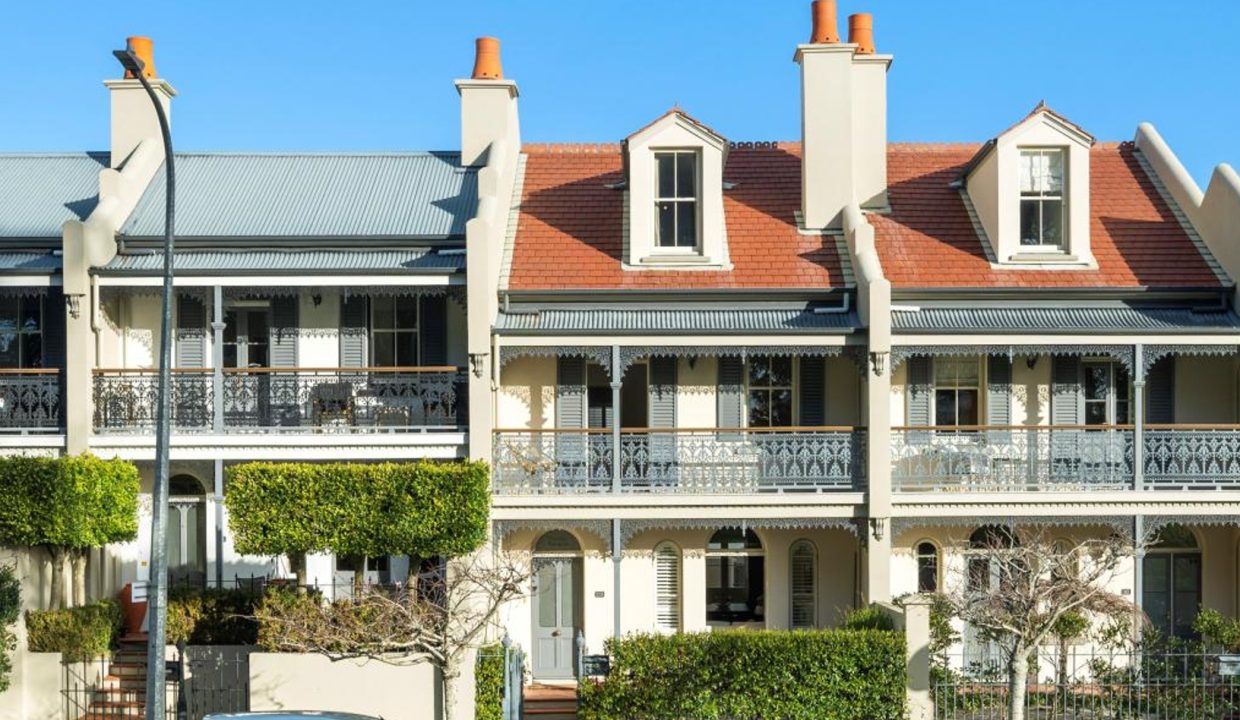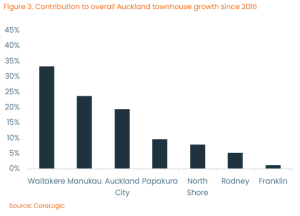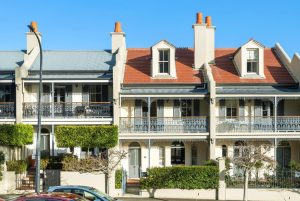
뉴질랜드 타운하우스 붐의 배경 분석
Behind the Boom in New Zealand Townhouses
‘Property Economist Kelvin Davidson Examines the Driving Forces of New Zealand’s Housing Construction Surge’
Townhouses have emerged as a significant growth driver in New Zealand’s housing market. Recent statistics reveal that townhouses now account for 45% of all new dwelling consents nationwide, a notable increase from just 6% in 2012.
Since 2016, a total of 39,600 townhouses have been constructed across New Zealand, with nearly 25,000 of these located in Auckland. Particularly in key Auckland areas such as Waitakere and Manukau, the townhouse stock has surged by over 50% since 2016.
In recent years, analysts and experts have focused on the sales activity and new dwelling consents related to townhouses and semi-detached units. This focus is justified by the fact that townhouses currently represent around 45% of all new dwelling consents, a sharp rise from 6% in 2012.
CoreLogic’s Market Trends data highlights the growing importance of townhouses and apartments, reflecting changes across various regions in New Zealand over time.
Looking at housing stock in 10-year intervals since the early 1980s, standalone houses comprised 80% of all dwellings in 1984, but this figure has now decreased to 75%. Conversely, the share of apartments and lifestyle properties has risen, with the proportion of townhouses and apartments remaining steady at 13% since 1984.
National data also conceals intriguing regional trends. In New Zealand’s three major centres (Wellington, Porirua, Lower Hutt, and Upper Hutt), the proportion of townhouses has been steadily increasing, particularly in Auckland where a noticeable uptick has been observed since 2016. This trend is attributed to the Unitary Plan and a shift towards more intensified housing on existing brownfields.
Christchurch still maintains a higher townhouse proportion at nearly 24% compared to Auckland’s 16%, but Auckland’s growth over the past 7-8 years has been more significant. Of the 39,600 townhouses built across New Zealand since 2016, approximately 25,000 have been constructed in Auckland, representing about 63% of the total growth. Auckland holds around 38% of the national stock of this property type.
CoreLogic data shows that the most significant increases in townhouse stock have occurred in Rodney, Papakura, Manukau, and Waitakere, with a rise of approximately 50% or more since 2016. However, due to the smaller size of the townhouse market in Rodney, the most substantial contributions to overall growth in Auckland have come from Waitakere (33%), Manukau (24%), and Auckland City (19%).
Separating supply from demand in analyzing the rise of townhouses is challenging. It remains unclear whether changing tastes led developers to respond or if buyers had to purchase what was available. However, it is clear that townhouses offer a lower price point compared to other dwelling types. For example, the current median value for Auckland flats and townhouses is about $775,000, compared to approximately $1.12 million for standalone houses.
In conclusion, townhouses have become a prominent feature of New Zealand’s housing market, particularly in major cities. Their efficient use of land and proximity to existing infrastructure make them an attractive and affordable option for a broader range of buyers. The government’s current ‘Going for Housing Growth’ policy is expected to continue supporting the townhouse construction sector in the medium term, alongside general growth in all dwelling types.


뉴질랜드 타운하우스 붐의 배경 분석
‘부동산 경제학자, 켈빈 데이비드슨이 뉴질랜드 주택 건설 붐의 동력을 분석하다’
뉴질랜드의 주택 시장에서 타운하우스가 중요한 성장 요소로 떠오르고 있다. 최근 통계에 따르면, 타운하우스는 뉴질랜드 전역의 모든 신규 주택 허가 중 45%를 차지하고 있다. 이는 2012년의 6%에서 큰 폭으로 증가한 수치이다.
2016년 이후 뉴질랜드 전역에서 39,600채의 타운하우스가 건설되었으며, 그 중 거의 25,000채가 오클랜드에서 지어졌다. 특히 오클랜드의 웨이타케레와 마누카우 등 주요 지역에서는 타운하우스 주택 수가 2016년 이후 50% 이상 증가했다.
최근 몇 년 간, 분석가들과 전문가들은 타운하우스와 반독립형 타운하우스의 판매 활동이나 신규 주택 허가에 주목해왔다. 이는 타운하우스가 현재 전체 신규 주택 허가의 약 45%를 차지하고 있기 때문인데, 2012년에는 이 비율이 6%에 불과했다.
코어로직의 시장 동향 데이터에 따르면, 타운하우스와 아파트의 중요성이 증가하고 있으며, 이는 시간이 지남에 따라 뉴질랜드의 여러 지역에서 변화해 왔다.
1980년대 초반부터 10년 단위로 주택 수를 살펴보면, 1984년에는 독립형 주택이 전체 주택의 80%를 차지했으나, 현재는 75%로 감소했다. 반면 아파트와 라이프스타일 주택의 비율은 증가했으며, 타운하우스와 아파트는 1984년 13%에서 현재까지 같은 비율을 유지하고 있다.
전국 데이터는 지역별로 흥미로운 트렌드를 숨기고 있다. 뉴질랜드의 세 주요 도시(웰링턴, 포리루아, 로워 헛, 업퍼 헛)에서 타운하우스 비율이 꾸준히 증가해왔으며, 특히 오클랜드에서 2016년 이후 뚜렷한 상승세를 보였다. 이는 유니타리 플랜과 기존의 브라운필드(재개발 가능 지역)에서의 고밀도 주거 개발 변화에서 비롯된 것이다.
크라이스트처치는 오클랜드보다 타운하우스 비율이 높은 24%를 기록하고 있지만, 최근 7-8년간 오클랜드의 성장세가 더 두드러진다. 2016년 이후 뉴질랜드에서 건설된 39,600채의 타운하우스 중 약 25,000채가 오클랜드에서 지어졌으며, 이는 전체 성장의 약 63%를 차지한다. 오클랜드는 이 유형의 주택에서 전국의 약 38%를 보유하고 있다.
타운하우스 주택 수가 가장 많이 증가한 지역은 코어로직의 데이터에 따르면 로드니, 파파쿠라, 마누카우, 웨이타케레 등으로, 이 지역들에서는 2016년 이후 타운하우스 재고가 약 50% 이상 증가했다. 하지만 로드니의 타운하우스 시장 규모가 작아, 오클랜드의 전반적인 성장 기여도는 웨이타케레(33%)와 마누카우(24%), 오클랜드 시내(19%)가 가장 크다.
타운하우스의 상승 원인을 공급과 수요로 나누어 분석하기는 어렵다. 수요의 변화와 개발자의 대응, 혹은 구매자들이 제공된 주택을 선택했을 가능성이 모두 포함될 수 있다. 그러나 분명한 것은 타운하우스가 다른 유형의 주택보다 낮은 가격으로 제공되며, 예를 들어 최근 오클랜드의 아파트와 타운하우스의 중위값은 약 77만 5천 달러로, 독립형 주택의 약 112만 달러에 비해 훨씬 저렴하다.
결론적으로, 타운하우스는 이제 뉴질랜드 주택 시장에서 중요한 위치를 차지하고 있으며, 특히 대도시에서 그 비중이 높다. 타운하우스는 토지 사용 효율이 높고 기존 인프라와 가까운 위치에 건설될 수 있어, 더 다양한 구매자들에게 저렴한 옵션을 제공한다. 현재 정부의 ‘주택 성장 추구’ 정책이 타운하우스 건설을 계속해서 지원할 것으로 기대된다.

